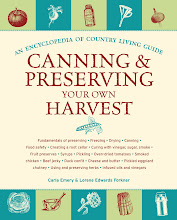Harvesting
Is the Sweet Corn Ready? There is one day of absolute perfection in corn ripeness, but you can actually start harvesting and eating several days before it, and continue several days after. How do you know when it is? In general, your corn will be ready 3 weeks after the tassels begin to shed pollen.Watch the Silk. A mature corn ear has dark-green husks and dried brown silk. Corn is starting to get dangerously near the overmature stage when the silk gets really dark brown or black. It may feel nice and plump, but it won't stay prime for more than a few days. If you think the silk looks dried enough, double-check by observing the milk.
Observing the Milk. Pull back a husk a couple inches to see if the kernels have filled out. Puncture a kernel with your thumbnail. The juice that comes out is corn "milk." Clear juice means the corn is not yet ready. As every day goes on, the milk changes. The milk is thickening because the sugar in it is gradually turning to starch. I think the perfect corn should practically squirt out milk when you dent it. Corn that's getting overripe will be moist but won't squirt. Really thick, "doughy," and yellow juice means prime harvest time has come and gone.
Uses for Overripe Sweet Corn. You can still get some good out of it. Make cream-style corn (use one of the recipes in this section that contains added ingredients). If your corn is so dry it looks more like popcorn, then follow the instructions for making hominy or cornmeal in the sections on harvesting and eating field corns (dent, flint, popcorn, and Indian corn). Or feed it, stalks and all, to animals.
Eating Sweet Corn
BEST CORN ON THE COBFor the very best-tasting corn of all, put your water on the boil, go out to pick the corn, run all the way from the field to the kitchen, and husk and cook it! Or for the super-absolute best, don't boil the corn at all--roast it in a 375°F oven for about 15 minutes. (Remove all but the inner layers of husks, take out the silk, and tie the ends of the remaining husk together with string.) Never salt corn until after you are all done cooking, because salt tends to toughen it. You can roast corn on a grill over coals as well as in the oven. If you're using a grill, shuck the corn first, lay the ears on the grill, and turn them every so often until roasted on all sides. It will take about 10 minutes.
SILK/HUSK TEA
Incidentally, you can make a nice "herbal" tea from the broth of corn silk and/or the husks. It has a corny flavor. Or you can actually throw them into the soup pot and get some good out of them that way. (Or give the animals. Or compost.)
CORN CAKES FROM LEFTOVER ROASTED OR BOILED CORN
When you have leftover boiled or roasted ears, split the kernels lengthwise with a sharp knife and scrape the corn from the cobs, leaving the hulls on the cobs. For every 6 ears of corn done this way, combine corn with 3 eggs, add salt and pepper to taste, form into small cakes, and fry to a nice brown.
Freezing Whole Kernel Corn
GOURMET FROZEN CORNCombine 15 cups freshly cut corn kernels (after blanching) with 1/2 lb. butter (or margarine), 1 qt. milk (Gertrude Johnson substitutes evaporated milk or light cream), and salt and pepper to taste. Pour into baking pan. Heat thoroughly in 325°F oven, stirring every 15 minutes until the butter is all melted and mixed through. Then cool, divide into your packages, and freeze.
VEGAN CREAM-STYLE CORN
Measure your freshly cut corn kernels in a pan. For every quart of kernels, add 1 c. boiling water into which 1 tablespoon cornstarch has been stirred. (Salt, pepper, herbs, and pimiento for seasoning are optional.) Heat the mixture to a boil; continue on low heat for 5 minutes (stir enough to prevent scorching!). Now move your pan into a sink of ice water and chill. Package and freeze. To cook, warm in the top of a double broiler.
[Adapted from "Corn" in Chapter 3: Grasses, Grains & Canes. Illustration copyright 1994 by Cindy Davis.]









No comments:
Post a Comment